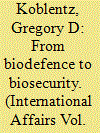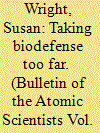|
|
|
Sort Order |
|
|
|
Items / Page
|
|
|
|
|
|
|
| Srl | Item |
| 1 |
ID:
105415


|
|
|
| 2 |
ID:
126242


|
|
|
|
|
| Publication |
2012.
|
| Summary/Abstract |
Since 2001, the United States government has spent substantial resources on preparing the nation against a bioterrorist attack. Earlier articles in this series have analyzed civilian biodefense funding by the federal government for fiscal years (FY) 2001 through proposed funding for FY2012. This article updates those figures with budgeted amounts for FY2013, specifically analyzing the budgets and allocations for civilian biodefense at the Departments of Health and Human Services, Defense, Homeland Security, Agriculture, Commerce, and State; the Environmental Protection Agency; and the National Science Foundation. As in previous years, our analysis indicates that the majority (>90%) of the "biodefense" programs included in the FY2013 budget have both biodefense and non-biodefense goals and applications-that is, programs to improve infectious disease research, public health and hospital preparedness, and disaster response more broadly. Programs that focus solely on biodefense represent a small proportion (<10%) of our analysis, as the federal agencies continue to prioritize all-hazards preparedness. For FY2013, the federal budget for programs focused solely on civilian biodefense totals $574.2 million, and the budget for programs with multiple goals and applications, including biodefense, is $4.96 billion, for an overall total of $5.54 billion.
|
|
|
|
|
|
|
|
|
|
|
|
|
|
|
|
| 3 |
ID:
111694


|
|
|
|
|
| Publication |
2012.
|
| Summary/Abstract |
The Seventh Review Conference of the Biological Weapons Convention (BWC), the first international treaty to outlaw an entire class of weapons, was held in Geneva in December 2011. On 7 December, Secretary of State Hillary Clinton became the highest-ranking US government official to address a BWC meeting. Secretary Clinton told the assembled delegation that 'we view the risk of bioweapons attack as both a serious national security challenge and a foreign policy priority'. At the same time, she warned that a large-scale disease outbreak 'could cripple an already fragile global economy'. Secretary Clinton's speech reflected a new understanding that the range of biological threats to international security has expanded from state-sponsored biological warfare programmes to include biological terrorism, dual-use research and naturally occurring infectious diseases such as pandemics. Recognizing these changes, President Barack Obama released a new national strategy for countering biological threats in 2009. This strategy represents a shift in thinking away from the George W. Bush administration's focus on biodefence, which emphasized preparing for and responding to biological weapon attacks, to the concept of biosecurity, which includes measures to prevent, prepare for and respond to naturally occurring and man-made biological threats. The Obama administration's biosecurity strategy seeks to reduce the global risk of naturally occurring and deliberate disease outbreaks through prevention, international cooperation, and maximizing synergies between health and security. The biosecurity strategy is closely aligned with the Obama administration's broader approach to foreign policy, which emphasizes the pragmatic use of smart power, multilateralism and engagement to further the national interest. This article describes the Obama administration's biosecurity strategy; highlights elements of continuity and change from the policies of the Bush administration; discusses how it fits into Obama's broader foreign policy agenda; and analyses critical issues that will have to be addressed in order to implement the strategy successfully.
|
|
|
|
|
|
|
|
|
|
|
|
|
|
|
|
| 4 |
ID:
073790


|
|
|
| 5 |
ID:
057789


|
|
|
|
|
| Publication |
Nov-Dec 2004.
|
|
|
|
|
|
|
|
|
|
|
|
|
|
|
|
|
|
|
|
|